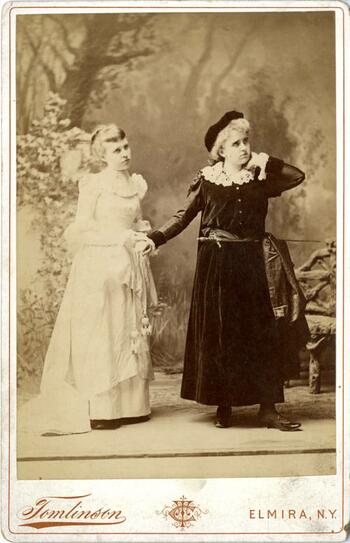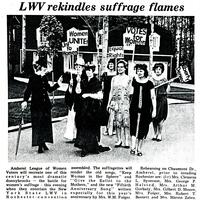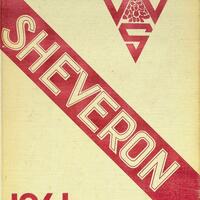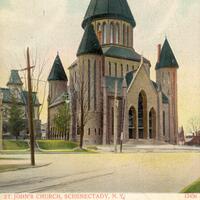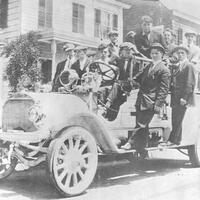The Elmira Female College opened to 242 students of various academic backgrounds and proficiencies for its first term in October, 1855. The construction of the academic building fell behind schedule and upon opening lacked the furnishings and amenities as promised in the prospectus; in fact, the college was without a President until the following year. Under the direction of Simeon Benjamin, the Board of Trustees moved quickly to inject stability into the venture and by 1856, Elmira Female College had made significant progress.
The administration secured Augustus Woodruff Cowles as the first president of Elmira Female College. In his inaugural address, Cowles established a guiding principle of the College: to “promote the rights of woman to a larger share of education… to furnish an institution where the most gifted and intellectual may pursue a course of thorough and extended study...”
Under the leadership of Dr. Cowles, the College overcame the difficult years of establishment: meeting a rigorous standard of academic excellence and achieving financial solvency to sustain the College, including the successful navigation of the lean economic climate resulting from the Civil War. After a thirty-three year tenure, Dr. Cowles stepped down as president in 1889. A succession of short-term presidents over the next seven years put newly adopted, “Elmira College,” in financial hardship and the intermittent return of Dr. Cowles to serve as President Emeritus was crucial in establishing administrative continuity during this era. The historic records under the short-term presidencies of Dr. Wilson Phraner, Dr. Charles Van Norden, and Dr. Rufus Smith Green are not well-documented.
Dr. Alexander Cameron MacKenzie assumed the presidency in 1896 until his death in 1915. MacKenzie’s tenure proved to be a success, after increasing enrollment and running two successful capital campaigns, President MacKenzie was able to bring much needed stability back to Elmira College. During the closing months of the MacKenzie era, suffrage fervor began to build. Although, there is no existing official statement made by the College regarding suffrage and no existing statement made by President MacKenzie (or any Elmira College President) on the issue, student and faculty involvement survives in the campus newspaper, EC Weekly, and in the student run creative writing publications, The Lepidotus and The Sybil. Faculty members hosted a suffrage agenda as illustrated in the December 1914 issue of The Sibyl, “Miss Osler [economics professor at Elmira College] had the pleasure of introducing the popular speaker, Mrs. Forbes-Robertson Hale, who lectured on the Feminist Movement at the women’s Federation Building, Thursday evening, November 13th.”
Dean M. Anstice Harris briefly held the position of acting president after the death of Dr. MacKenzie in March, 1915, and is the only woman to have held the position at Elmira College. Dr. John Balcom Shaw was inaugurated as the 6th President of Elmira College in November, 1915. In his inaugural address, Shaw recognizes the strengthening woman’s movement, stating, “The supreme object of my thought lies far out beyond the perimeter of this institution’s life or interest. It is the call of modern womanhood that I am least able to shut out of my ears at this time. This is pre-eminently woman’s day, and that day is only just opening. She is now coming into her own by leaps and bounds. All callings fling wide their doors to her; all classes are uniting to give her coronation. Three outstanding words tell the whole story of womanhood’s new birth—equality, opportunity, regnancy.”
Elmira College students experienced similar tensions on campus that were manifested in the local and national discourse. Students hosted a suffrage night on Oct. 28, 1915. The suffrage night was described in the November 1915 issue of The Sybil, “There were two booths, yellow and red—each flaring its posters, literature, stamps, pins, ribbons, flowers, etc. Although the Suffrage followers were very much in majority, the Antis did not lack for adherents. Most of the girls came out very strongly for either one side [or] the other; there were few neutrals.”
Students were actively involved with the campaign to pass suffrage on and off campus. The November 12, 1917 issue of the Elmira College Weekly states, “The college girls under the leadership of Catherine Morgan, personally interviewed some 900 men of the seventh ward… Over 1500 letters were addressed and sent out from the college to voters. Some thirty girls, rounded up by Pick [Hannah Pickering], tumbled out of their warm beds in the cold grey dawn, for once without muttered imprecations at the alarm clock, to tackle unsuspecting victims approaching the polls. Miss Osler’s entire government class was conscripted to appear on the scene of the conflict to enlarge their political education (No exemptions allowed). The passage continues:
A miniature campaign was staged within the college. On Monday night a parade and mass meeting was held at which noise was the most conspicuous feature. A regular election with rigid registration and voting rules was carried on in the most approved official manner. Marjorie Hough, as Commissioners of Elections, made a ruling right and left and cruelly cast out Pick’s vote because she didn’t register properly. The “soldiers’ vote” (of those at the polls) helped to swell the suffrage vote. Complete returns showed that suffrage won by the overwhelming majority of 99 to 40.”
There are no existing records of a statement made by President Shaw after suffrage passed in New York State. Shaw stepped down from the Presidency in 1918 and was replaced by Dr. Frederick Lent. Dr. Lent was President when the 19th Amendment was adopted on August 18, 1920. In the immediate aftermath, no mention of the passage of the Amendment was made by Lent in any existing address, in official College literature, in the student run newspaper, Elmira College Weekly, or the literary magazine, The Sibyl.
